 James Hansen worries that “we may be approaching a point of no return, a situation in which our children inherit a climate system undergoing changes that are out of their control, changes that will cause them irreparable harm”. He’s looked at the models, at current observations, and at what happened during the Eemian interglacial 118,000 years ago, and he doesn’t like what he sees.
James Hansen worries that “we may be approaching a point of no return, a situation in which our children inherit a climate system undergoing changes that are out of their control, changes that will cause them irreparable harm”. He’s looked at the models, at current observations, and at what happened during the Eemian interglacial 118,000 years ago, and he doesn’t like what he sees.
During the Eemian, when global average temperatures were about 1°C more than now, sea level was about 3-4 metres higher than now for a considerable time. Then about 118,000 years ago, towards the end of the interglacial, it peaked at 6-9 meters, including a rise of 2-3 metres within several decades. A similar sea level rise of several metres now would see the inundation of many of the world’s major cities.
Also there were huge storms at mid-latitudes in the North Atlantic which would make Superstorm Sandy look mild. Hansen thinks that climate change may be entering a phase where similar events could occur this century.
As background, in my post Scoping long-term sea level rise I cited IPCC5 WGI Chapter 13 as giving the following breakup of the contributing factors to SLR:
-
Thermal expansion – 1.1mm
Glaciers except Greenland and Antarctica – 0.76mm
Greenland – 0.33mm
Antarctica – 0.27mm
Land water storage – 0.38mm
Total – 2.8mm
Observed SLR – 3.2mm
Residual – 0.4mm
Concerning the residual, more recent research indicates that thermal expansion may have been underestimated.
Greenland and Antarctica combined only contribute 0.6mm pa to sea level rise, a minor contribution. Yet we know that sooner or later ice sheet decay is going to become the main driver. Hansen thinks that may be starting to happen now, with cool fresh meltwater spilling into the ocean from Greenland and Antarctica, disrupting the huge ocean currents, the Atlantic Meridional Overturning Circulation (AMOC) and the Southern Ocean Meridional Overturning Circulation (SMOC).
At this point I should mention that Hansen’s paper has 18 very distinguished joint authors. This site has an abbreviated version of the ‘Ice Melt Paper’, plus links to the full version, an explanatory video and three newspaper articles. Elsewhere there’s a transcript of the video, a post at Open Mind with a long discussion thread, and a post by Graham Readfearn.
Hansen et al show a map of the January-February 2016 global temperature pattern, which is very similar to this NASA map for March via Open Mind, which I’ve used as it highlights the important features more clearly:
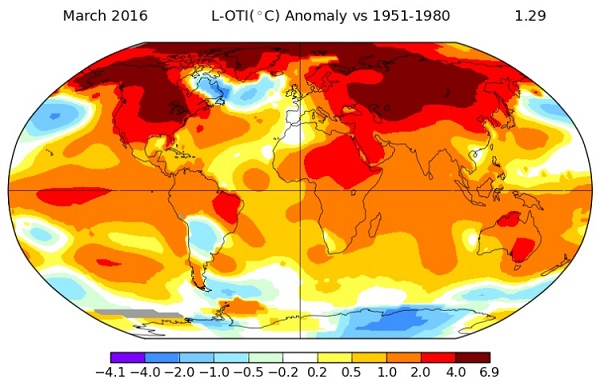
The important features are the cool patch in the North Atlantic, the warming immediately below and near the east coast of the USA (that water was 3°C warmer than normal during Hurricane Sandy) and the ocean cooling near Antarctica, which possibly has even greater potential for sea level rise.
Hansen et al looked at the models, which they say are lethargic compared to real world observations and assume more deep water mixing than actually takes place, so they looked to paleoclimate evidence to see what might happen. While the Eemian is not an analogue for future climate change, it has clues which contribute to what may actually happen in the the pattern of ice sheet decay.
Their conclusions are best summarised in the abstract of the main paper:
- The modeling, paleoclimate evidence, and on-going observations together imply that 2°C global warming above the pre-industrial level could be dangerous. Continued high fossil fuel emissions this century are predicted to yield (1) cooling of the Southern Ocean, especially in the Western Hemisphere; (2) slowing of the Southern Ocean overturning circulation, warming of the ice shelves, and growing ice sheet mass loss; (3) slowdown and eventual shutdown of the Atlantic overturning circulation with cooling of the North Atlantic region; (4) increasingly powerful storms; and (5) non-linearly growing sea level rise, reaching several meters over a timescale of 50–150 years.
These predictions differ fundamentally from existing climate change assessments, for example they suggest “markedly reduced warming or even cooling in Europe”.
This image shows the global temperature pattern predicted in 2055-2060 with one metre of ice melt:
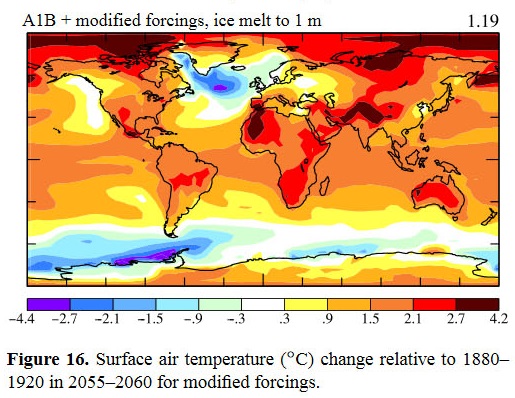
The overall pattern looks remarkably like what we’ve been getting recently. Noteworthy is that the Arctic is still seen as warming, contra the discussion at Open Mind.
The basic physical mechanism is that cool water just above freezing point pools near the surface, as it is less dense than saltwater, so it doesn’t sink. However, global warming continues, with the excess heat taken up elsewhere, not least in the ocean. The paper goes into feedback mechanisms whereby ice sheet melting is speeded up.
They think ice sheet melting may on average double every 10, 20 or 40 years, and have developed scenarios to illustrate what may happen. The following graph models the global temperature rise with 1 metre and 3.8 metres of melt water:
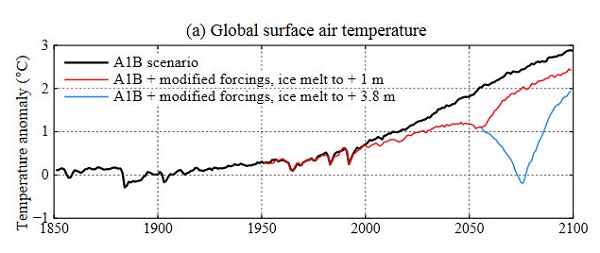
If the Atlantic Meridional Overturning Circulation (AMOC) stops, Hansen says All Hell Will Break Loose with huge storms at mid-latitudes and sea level could take off to the extent that we may have several metres this century.
It would take centuries for AMOC to restart, whereas SMOC could crank up again after decades.
Hansen and company are not certain they are right so they discuss observations and modelling studies needed to refute or clarify their assertions. Hansen thinks we haven’t reached a point of no return, but the future looks complicated, non-linear, uncertain and with considerable risk. The possibilities are alarming. Hansen says “we have a global emergency. Fossil fuel CO2 emissions should be reduced as rapidly as practical.”
Out of interest, this graph from the paper shows trends in sea level rise:
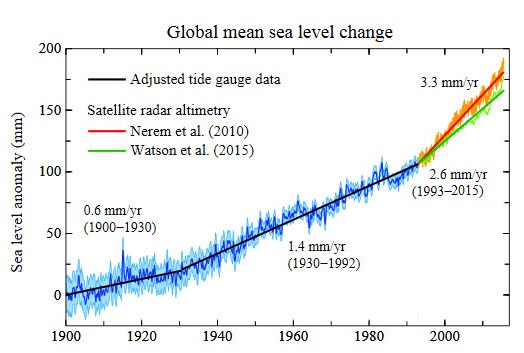
This graph shows the typical climate response time of most climate models:
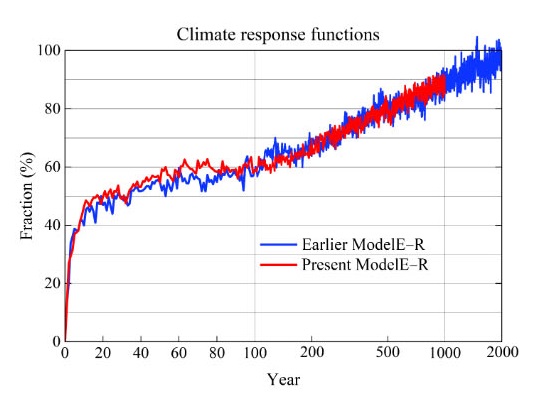
The graph shows the percentage response if a quantity of CO2 is dumped into the atmosphere. About half the eventual response comes in the first 20 years, but only 60% in the first hundred. Hansen et al think that 75% may be more accurate.
However, the main problem is that most models used by IPCC simply exclude ice melt, and most models don’t deal with added freshwater in a way that reflects the real world. Hansen and his colleagues have had a go at rectifying these deficiencies.

You know it. I know it now. A lot of other people know it. So why do we still have to effects of short-term greed and an irrational hostility to beneficial or remedial change damaging our planet?
Hansen is, of course, correct with the only variable being timing. Animal life on this planet is heading for a wild ride. Hanging on will be difficult and the numbers of casualties will be horrendous. Denialists cling to the belief that “we will just adapt”, “the strong will survive and the weak (all of those people the strong have no feeling for) will perish”. The strong are presumed to be the rich and the clever. In the end game I don’t think that it works like that. When climate becomes chaotic its impacts will be massive and unpredictable. Creatures with the longest lives requiring stability will be the early casualties. Humans require a stable environment. It takes years for us to develop and we require a considerable amount of information to be passed forward for us to be successful.
The best thing we can be doing is minimising the deterioration towards destructive climate change. The easy period for global warming action has passed without sufficient change thanks to the Denialist leaders of which Australia has more than its fair share, so as we move forward the changes required will become more extreme.
BilB: Looking at what you said from a military rather than an environmental or social justice perspective.
Wonder if the Denialists realize that in putting forward Australia as a world leader in exacerbating climate change, they are giving the rest of the world an excuse to launch a war of revenge against Australia once the climate situation becomes intolerable?
Of course, when that happens. the Denialists can then charter an aircraft to fly them to an Antarctic beach resort …. in response to which, the commander of an antiaircraft unit from a fried-and-boiled country would simply say, “Azimuth set. Range set. Launch!”
Don’t think there’ll be a war here, though possibly trade reparations. It’s fairly well recognised in security circles, though, that climate change increases the risk of state failure and perhaps local wars over resources. Some argue that’s already happened.
BilB, whether it’s as bad as Hansen worries about or not, things are gradually going pear-shaped and sometime within the next 15 years or so it will be obvious to everyone, except the hard cases, like anti-vaxxers, or people that think the moon landings were faked.
People don’t care much about animals, but the reef bleaching will eventually get a message across, especially as millions of people who rely on reefs for their protein will have to find tucker elsewhere.
Bad weather can be dismissed as cyclical, but sea level rise is inexorable. Try googling “Miami sea level rise”. One of the articles, by Elizabeth Kolbert, says:
New York, Tokyo and other important cities are in the frame.
If we get to four degrees then the stability of civilisation as we know it is certainly at risk.
The war I spoke of Brian is a war against Global Warming and Climate Change. If you mean that there will be no war with the government we have then you are probably right, but there does need to be a war.
Yes, GrahamB, I think high profile Denialists will be treated very harshly in the not to distant future. Of course many of them will be dead,being elderly already, when this time comes, but there are many others.